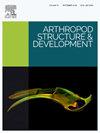Tyrosine hydroxylase- and serotonin-immunoreactive neurons in the thoracic ganglia of the Oriental fruit fly, Bactrocera dorsalis
IF 1.3
3区 农林科学
Q2 ENTOMOLOGY
引用次数: 0
Abstract
The thoracic ganglia (TG) of insects are essential neural centers responsible for regulating behaviors such as flight and courtship. These ganglia control thoracic muscle movements through the release of biogenic amines, such as dopamine and serotonin, which modulate motor functions and behavioral outputs. The Oriental fruit fly, Bactrocera dorsalis (Hendel), is a major agricultural pest characterized by strong flight and reproductive capabilities. These traits enable rapid dispersal and population establishment, posing significant threats to crop production. Elucidating the neural mechanisms of flight and mating behaviors in B. dorsalis is crucial for developing effective pest management strategies. However, the functional roles of biogenic aminergic neurons in the TG of this species remain poorly understood. This study aimed to elucidate the role of biogenic amines in regulating flight and courtship behavior by employing immunohistochemical techniques using tyrosine hydroxylase (TH, a rate-limiting enzyme in dopamine biosynthesis) and serotonin (5-hydroxytryptamine, 5-HT) antibodies. Using confocal laser scanning microscopy, we analyzed and identified TH immunoreactive (TH-ir) and 5-HT immunoreactive (5-HT-ir) neurons in the TG. Their axonal projections were reconstructed in three dimensions. We identified 10 5-HT-ir and 10 TH-ir neurons. These neurons were primarily distributed in the ventral regions of the TG, located between adjacent neuromeres. The 5-HT-ir neurons exhibited extensive projections throughout the TG with a bilateral projection pattern. In contrast, TH-ir neurons displayed more restricted projection areas. Notably, the cell bodies and axonal projections of these two neuron types were entirely independent, with no co-localization observed. This study provides a comprehensive map of putative dopaminergic and serotonergic neurons in the TG of B. dorsalis, laying a foundation for future research on their roles in behavioral regulation.
东方果蝇背小实蝇胸椎神经节中酪氨酸羟化酶和血清素免疫反应神经元
昆虫的胸神经节(TG)是调节飞行、求偶等行为的重要神经中枢。这些神经节通过释放生物胺来控制胸肌运动,如多巴胺和血清素,它们调节运动功能和行为输出。东方果蝇(Bactrocera dorsalis, Hendel)是一种主要的农业害虫,具有很强的飞行和繁殖能力。这些特性使其能够迅速扩散和种群建立,对作物生产构成重大威胁。阐明背家蝇飞行和交配行为的神经机制对制定有效的害虫防治策略具有重要意义。然而,生物胺能神经元在该物种TG中的功能作用仍然知之甚少。本研究旨在通过免疫组织化学技术,利用酪氨酸羟化酶(TH,多巴胺生物合成中的限速酶)和5-羟色胺(5-羟色胺,5-HT)抗体,阐明生物胺在调节飞行和求爱行为中的作用。使用激光共聚焦扫描显微镜,我们分析并鉴定了TG中TH免疫反应(TH-ir)和5-HT免疫反应(5-HT-ir)神经元。对其轴突投影进行三维重建。我们鉴定了10个5-HT-ir和10个TH-ir神经元。这些神经元主要分布在TG的腹侧区域,位于相邻神经粒之间。5-HT-ir神经元在整个TG中表现出广泛的双侧投射模式。相比之下,TH-ir神经元显示出更有限的投射区域。值得注意的是,这两种神经元类型的细胞体和轴突突起完全独立,未观察到共定位。本研究提供了dorsalis TG中可能存在的多巴胺能和血清素能神经元的完整图谱,为进一步研究它们在行为调节中的作用奠定了基础。
本文章由计算机程序翻译,如有差异,请以英文原文为准。
求助全文
约1分钟内获得全文
求助全文
来源期刊
CiteScore
3.50
自引率
10.00%
发文量
54
审稿时长
60 days
期刊介绍:
Arthropod Structure & Development is a Journal of Arthropod Structural Biology, Development, and Functional Morphology; it considers manuscripts that deal with micro- and neuroanatomy, development, biomechanics, organogenesis in particular under comparative and evolutionary aspects but not merely taxonomic papers. The aim of the journal is to publish papers in the areas of functional and comparative anatomy and development, with an emphasis on the role of cellular organization in organ function. The journal will also publish papers on organogenisis, embryonic and postembryonic development, and organ or tissue regeneration and repair. Manuscripts dealing with comparative and evolutionary aspects of microanatomy and development are encouraged.

 求助内容:
求助内容: 应助结果提醒方式:
应助结果提醒方式:


